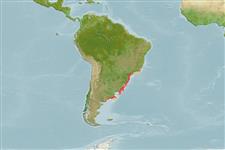Environment: milieu / climate zone / depth range / distribution range
Ecology
Marine; demersal; depth range 5 - 15 m (Ref. 26375). Subtropical; 22°S - 41°S, 64°W - 40°W
Southwest Atlantic: Rio de Janeiro, Brazil to northern Argentina.
Size / Weight / Age
Maturity: Lm ? range ? - ? cm
Max length : 31.0 cm SL male/unsexed; (Ref. 27363); common length : 18.0 cm TL male/unsexed; (Ref. 6077)
Short description
Identification keys | Morphology | Morphometrics
Found in sandy bottoms, gravel or mud, adults between 5-15 m, juveniles between 0-5 meters on the edge of beaches and protected bays (Ref. 26375).
Life cycle and mating behavior
Maturities | Reproduction | Spawnings | Egg(s) | Fecundities | Larvae
Cervigón, F. and W. Fischer, 1979. INFOPESCA. Catálogo de especies marinas de interes economico actual o potencial para América Latina. Parte 1. Atlántico centro y suroccidental. FAO/UNDP, SIC/79/1. 372 p. FAO, Rome. (Ref. 6077)
IUCN Red List Status (Ref. 130435)
Threat to humans
Venomous
Human uses
Fisheries: minor commercial
Tools
Special reports
Download XML
Internet sources
Estimates based on models
Preferred temperature (Ref.
123201): 14.3 - 18.5, mean 16.3 °C (based on 72 cells).
Phylogenetic diversity index (Ref.
82804): PD
50 = 0.5625 [Uniqueness, from 0.5 = low to 2.0 = high].
Bayesian length-weight: a=0.01230 (0.00694 - 0.02182), b=3.03 (2.87 - 3.19), in cm total length, based on LWR estimates for this species & (Sub)family-body (Ref.
93245).
Trophic level (Ref.
69278): 4.3 ±0.8 se; based on size and trophs of closest relatives
Resilience (Ref.
120179): Medium, minimum population doubling time 1.4 - 4.4 years (Preliminary K or Fecundity.).
Fishing Vulnerability (Ref.
59153): Low to moderate vulnerability (28 of 100).
